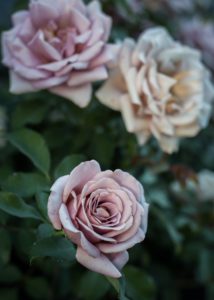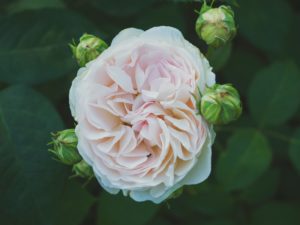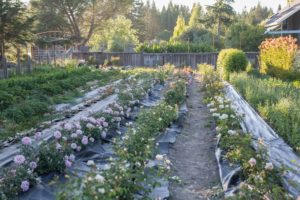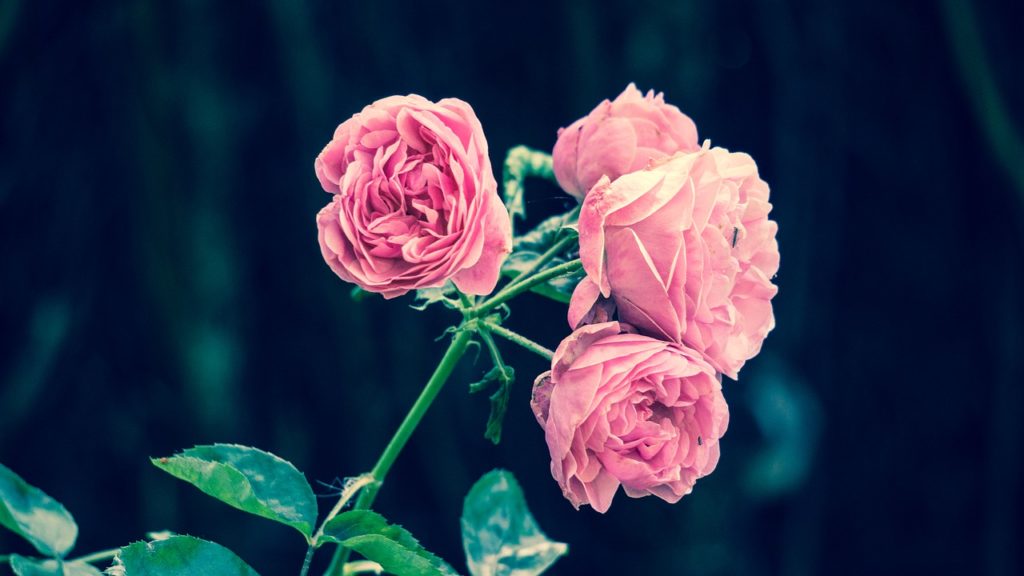 I planted about 100 roses this past winter. It took months and months, through storms and heat, and hungry deer (and the tedious erecting of a deer fence), but this summer they finally took off and have just finished their second burst of blooms. As we all know, roses are needy beasts. Everyone under the sun has their own ideas on summer rose care, so I had to dig into the books a bit to figure out exactly what to do.
I planted about 100 roses this past winter. It took months and months, through storms and heat, and hungry deer (and the tedious erecting of a deer fence), but this summer they finally took off and have just finished their second burst of blooms. As we all know, roses are needy beasts. Everyone under the sun has their own ideas on summer rose care, so I had to dig into the books a bit to figure out exactly what to do.
Before we talk about summer rose care, let me tell you a little bit about the winter work of getting them into the ground. Like the more large-scale rose growers I aspire to be, I planted bare root roses in the dead of winter. You can, of course, plant potted plants as well. But for a cheaper option that is often believed to establish more quickly and thoroughly in your soil, bare roots are the way to go. I chose about ten different varieties from David Austin Roses, based mainly on color selection.
Pruning
 For rosarians growing their roses to decorate the garden, careful pruning is an integral part of the management plan. For many cut flower growers however, they just aim to cut deep into the plant whenever harvesting stems, therefore eliminating the need for any big pruning.
For rosarians growing their roses to decorate the garden, careful pruning is an integral part of the management plan. For many cut flower growers however, they just aim to cut deep into the plant whenever harvesting stems, therefore eliminating the need for any big pruning.
While dormant-season rose pruning is often a bigger process than summer pruning, there are certainly cuts to be made in the summer. The best time to summer prune is directly following a big flush of blooms. Begin by pruning out any dead or dying stems, or anything that looks diseased (be sure to collect the debris from the garden floor so as not to spread disease). Next move on to deadheading spent blooms, cutting a few inches down the stem to just above a leaf set. As with most woody pruning, cut at a diagonal so that any condensation drips off the stem at an angle.
Finally, spend a little time shaping bushes that look big and healthy. With roses you always want to focus on light and air flow, so don’t neglect the middle of the plant. Prune out a few select branches that crowd the center. Beyond that, feel free to cut down any long branches by about 1/3 of their length.
Water
 Roses are thirsty! There are seemingly millions of factors that influence the decision of how much and how often to water your roses: climate, soil type, rose variety, and on and on. At a minimum, your roses will need about 4 – 5 gallons a week. On my farm, this means that I have irrigation lines set up so that each rose has two 1-gallon-per-hour emitters on it, which I leave on for one hour, twice a week.
Roses are thirsty! There are seemingly millions of factors that influence the decision of how much and how often to water your roses: climate, soil type, rose variety, and on and on. At a minimum, your roses will need about 4 – 5 gallons a week. On my farm, this means that I have irrigation lines set up so that each rose has two 1-gallon-per-hour emitters on it, which I leave on for one hour, twice a week.
During hot summer months your roses may need deeper watering. Resist the urge to water them frequently but lightly. The goal (as with all plants) is to encourage deep roots that stretch down for water, making the plant more resistant to the harsh effects of drought or winter freezes.
Feeding
 Roses are the hungriest plant I grow. We all know that roses in the wild or in neglected gardens can live on for years without any attention. But to get a rose bush to truly perform for you, year after year with long strong stems and abundant blooms, they need to be fed regularly.
Roses are the hungriest plant I grow. We all know that roses in the wild or in neglected gardens can live on for years without any attention. But to get a rose bush to truly perform for you, year after year with long strong stems and abundant blooms, they need to be fed regularly.
Rose-specific fertilizers rich in nitrogen, phosphorus and potassium are a great bet, as are alfalfa pellets, fish/kelp solution, and even aged manure & compost such as Grab N’ Grow Organic Compost. Many people feed their roses every four weeks. At a minimum, it’s a great idea to give roses a heavy feeding a few weeks after planting, and after each bloom cycle.
Now it’s out into the garden for some pruning!


 Family
Family

